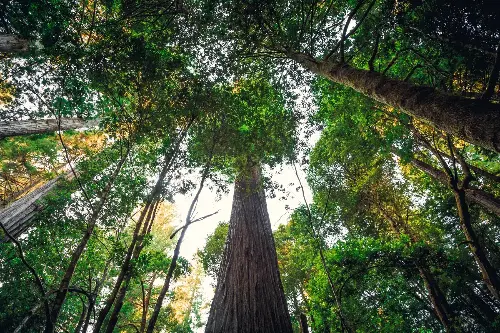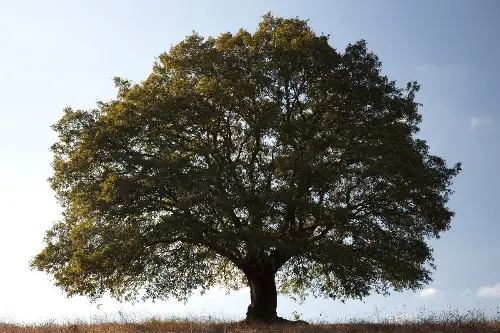In the hushed sanctuaries of the world’s forests, there stand living legends so colossal that their very existence seems to belong to the domain of fables. They are the giants of the forest, towering trees that have witnessed the unfolding of centuries, the frolic of countless generations of wildlife, and the changing tapestry of the natural world. Let us embark on a journey to meet the five tallest trees on Earth and unravel their astonishing natural secrets.

The Unassailable Reign of Hyperion
Hidden within the misty confines of California’s Redwood National Park is a titan that wears the crown of the tallest tree on Earth. Known as Hyperion, this coast redwood (Sequoia sempervirens) soars to a staggering height of 115.85 meters (380.1 feet). Discovered in 2006, this arboreal giant boasts an estimated age of 600 years, though redwoods can live for over 2,000 years. The precise location of Hyperion is kept secret to protect it from the throngs of curiosity seekers, as human foot traffic can damage the fragile ecosystem that nourishes this forest monarch.
The Towering Majesty of Helios
A stone's throw away from Hyperion stands Helios, another coast redwood that proudly claims the title of the second-tallest tree on the planet. Its commanding presence reaches up to 114.58 meters (375.9 feet), a mere whisper away from its taller sibling. Helios is a testament to the resilience and grandeur of the redwood species, an iconic representative of California's natural heritage.
The Stalwart Presence of Icarus
Barely conceding to Helios, Icarus too is a coast redwood securely perched within the protective embrace of Redwood National Park. Named after the Greek mythological figure who dared to fly too close to the sun, Icarus stretches up to 113.14 meters towards the skies. Yet, despite its lofty aspirations, the tree remains grounded in the humbling harmony of its ecosystem.

The Resplendent Crown of Stratosphere Giant
Once the titleholder for the tallest tree in the world, Stratosphere Giant has found its resting place fourth on our list. Located in Humboldt Redwoods State Park, another gem within California, this coast redwood measures a formidable 112.83 meters (370.5 feet). Its name aptly suggests its proximity to the heavens, and although surpassed by its peers, the respect it commands remains undiminished.
The Ephemeral Grace of Centurion
Journey far from the Californian shores, to the island of Tasmania, Australia, where the lone Eucalyptus regnans, known as Centurion, claims the title of the world's tallest hardwood tree. Measuring 100.5 meters (329.7 feet) in height, Centurion is not just the tallest tree in Australia but also represents the tallest flowering plant on the globe. This species, also known as the mountain ash, has been known to live for over 400 years, withstanding the challenges of both nature and humankind.
The Biology of Titans: Understanding the Skyward Surge
What drives these silent giants to reach such dizzying heights? The answer lies in a combination of genetic predisposition, ideal environmental conditions, and a dash of botanical mystery. Coast redwoods, for instance, benefit from the fog-laden climate of the American Pacific Northwest, where moisture condenses on their needles and drips to the forest floor, providing vital hydration. Moreover, their bark is fire-resistant, an adaptation that has allowed them to survive and flourish for millennia.
Similarly, the mountain ash requires the rich, moist soil found in the Tasmanian forests to support its vast needs as it stretches skyward. These giants compete for sunlight, which drives their upward growth, as well as for the nutrients and water essential to sustain their immense structures. Far from being inert, they are dynamic organisms that have fine-tuned their existence to capitalize on their ecosystems.

Guardians of the Forest: The Role of the Tallest Trees
The tallest trees are far more than impressive natural spectacles; they are also pivotal to the health of their respective ecosystems. As they rise above the forest canopy, they create habitats for various species of flora and fauna. Their extensive root systems contribute to soil stability and water regulation. Furthermore, as prodigious absorbers of carbon dioxide, these forest giants are essential players in the fight against climate change, sequestering vast amounts of carbon within their massive trunks.
Conservation Efforts: Protecting the Giants of the Forest
As sentinels of the forest, these tallest trees face numerous threats, including logging, climate change, and habitat fragmentation. Preservation is critical to ensure they continue to grace our planet with their splendor and provide the myriad ecological services that benefit all life forms. Organisations and governments are working tirelessly to protect these trees through national parks, conservation initiatives, and research programs aimed at understanding and mitigating the risks they face.
In the towering presence of the world’s tallest trees, we find a source of wonder and inspiration. As symbols of nature’s immense power and beauty, they draw us into a deeper appreciation of the natural world and our responsibility to protect it. As we walk beneath their lofty canopies and marvel at their grandeur, let us remember that they, too, rely on us to stand tall as their guardians, ensuring that their legacies reach even greater heights for generations to come.
